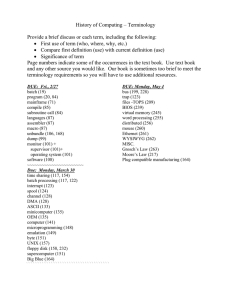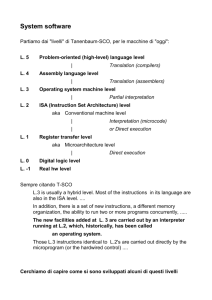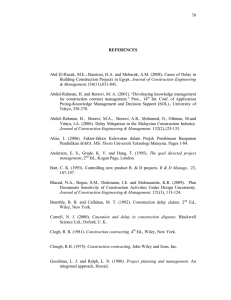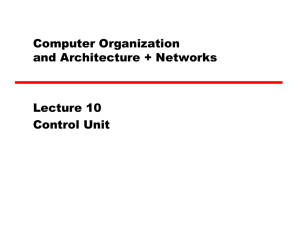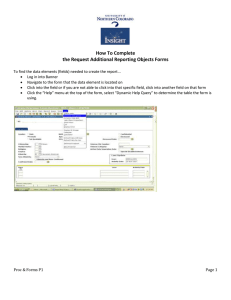GrowthofInterestinMicroprogrammingACMCompSurveysSept1969
advertisement
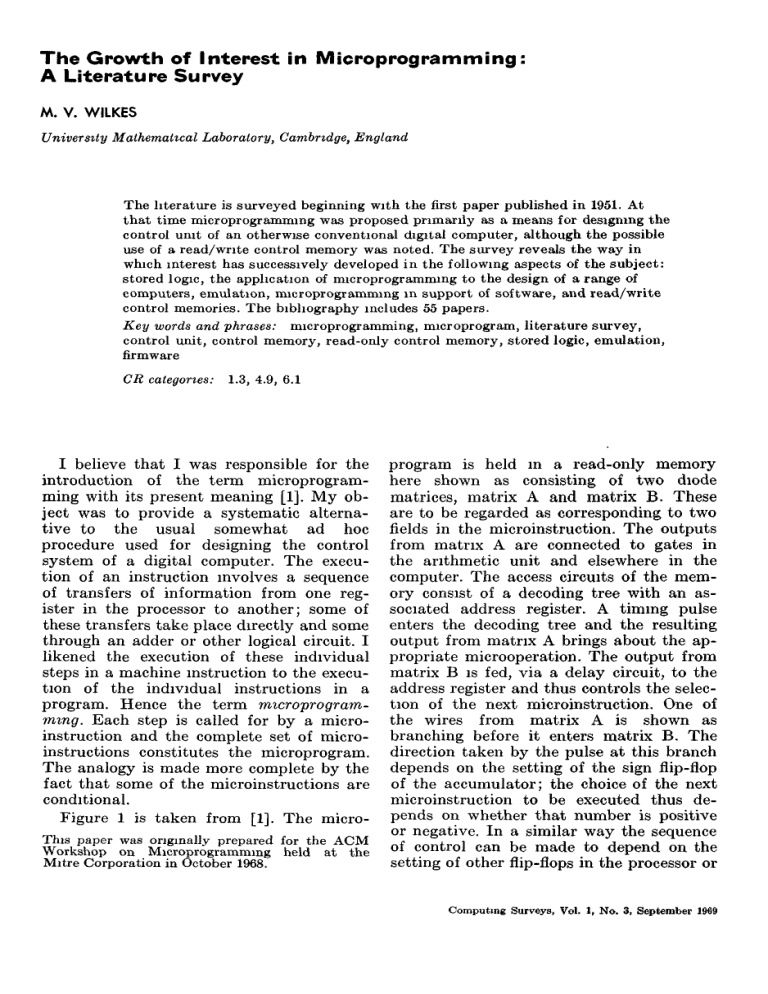
T h e G r o w t h of I n t e r e s t in M i c r o p r o g r a m m i n g A L i t e r a t u re Su rvey : M. V. WILKES University Mathemat,cal Laboratory, Cambmdge, England The literature is surveyed beginning with the first paper published in 1951. At that time microprogrammmg was proposed primarily as a means for designing the control umt of an otherwme conventmnal digital computer, although the possible use of a read/write control memory was noted. The survey reveals the way in which interest has successively developed in the following aspects of the subject: stored logic, the apphcatmn of m]croprogrammmg to the design of a range of computers, emulatmn, m]croprogrammmg m support of software, and read/write control memories. The bibliography includes 55 papers. Key words and phrases: mlcroprogramming, mmroprogram, literature survey, control unit, control memory, read-only control memory, stored logic, emulation, firmware CRcategorzes: 1.3, 4.9, 6.1 I believe that I was responsible for the introduction of the term microprogramming with its present meaning [1]. My object was to provide a systematic alternative to the usual somewhat ad hoc procedure used for designing the control system of a digital computer. The execution of an instruction revolves a sequence of transfers of information from one register in the processor to another; some of these transfers take place directly and some through an adder or other logical circuit. I likened the execution of these individual steps in a machine instruction to the execution of the individual instructions in a program. Hence the term mzcroprogrammmg. Each step is called for by a microinstruction and the complete set of microinstructions constitutes the microprogram. The analogy is made more complete by the fact that some of the microinstructions are conditional. Figure 1 is taken from [1]. The microThis paper was originally prepared for the ACM Workshop on Mlcroprogramming held at the Mitre Corporation in October 1968. program is held m a read-only memory here shown as consisting of two diode matrices, matrix A and matrix B. These are to be regarded as corresponding to two fields in the microinstruction. The outputs from matrix A are connected to gates in the ar]thmetic unit and elsewhere in the computer. The access circmts of the memory consist of a decoding tree with an associated address register. A timing pulse enters the decoding tree and the resulting output from matrix A brings about the appropriate microoperation. The output from matrix B Is fed, via a delay circuit, to the address register and thus controls the selectmn of the next mieroinstruction. One of the wires from matrix A is shown as branching before it enters matrix B. The direction taken by the pulse at this branch depends on the setting of the sign flip-flop of the accumulator; the choice of the next microinstruction to be executed thus depends on whether that number is positive or negative. In a similar way the sequence of control can be made to depend on the setting of other flip-flops in the processor or Computing Surveys, Voi. 1, No. 3, September 1969 140 • M. V. Wilkes DECOOING T R e e ,__~A_~_A__ [ i Illllllll I r _ MAZ~X_ B ~tttttttil I i I lliiitTll ;~,'i -' TO GATES IN ARITHMETICAL UNIT ETC DELAY ' i IlllTI II1111 I , iil~ii ; 111111 ITIII IIIli ' iJ]il; LW~,-V II FROM SIGN FLIP-FLOP OF ACCUMULATOR FIG 1 elsewhere. If desired, the branch can be between the decoding tree and matrix A; m this case the microoperation itself, as well as the sequence of control, can be made to depend on the setting of the flipflop m question. The Whirlwind computer at MIT made use of a diode matrix in its sequencing circuits, although the analogy with programmmg was absent; this use of the diode matrix may, however, be regarded as an antecedent to the scheme shown in Figure 1. The term microprogramming has also been used, notably at the Lincoln Laboratory, to describe a system in which individual bits in an instruction control directly certain gates in the processor. Work by van der Poel [11, 22] falls into this category. Such schemes give the programmer a larger repertoire of instructions than he would normally have. There is not very much in common, however, between this type of programming and the type with which I am primarily concerned in this paper. Comments on the two types of microprogramming were made by Beckman, et al [15]. The ideas outlined in [1] were elaborated in other papers by myself and my colleagues [2, 3, 7, 8] I was personally at pains to specify from the outset that I regarded microprogramming as a method of designing the control unit of an otherwise conventional digital computer, that is, one with a fixed instruction set. Besides being less "ad hoc" than conventional methods, a Computing Surveys, Vol 1, No. 3, September 1909 design based on microprogramming would enable decisions about details of the instruction set to be postponed until a late stage m the construction of the computer, and to be less influenced by exigencies of implementation. It would even be possible to change, or add to, the instruction set after the machine was completed. The use of a read-write memory instead of a read-only memory to hold the microprogram so that the programmer could set up his own mlcroprogram was mentioned as an intriguing possibility, but I doubted whether a computer designed in that way was really needed. Such computers have, however, been built and much interest is now being shown in then]. Reference [7] describes the control system of a computer built at the University of Cambridge and known as EDSAC 2. The read-only memory was composed of a matrix of fernte cores through which wires were threaded. The same microprogram matrix controlled all operations of the computer, including fixed-point and floating-point arithmetic operations, the action of the peripheral devices, including magnetic tape, and the internal sequencing of the core memory Billing and Hopmann published a paper in 1955 in which they discussed general principles of microprogramming and their practical application [4]. Glantz [5] and Mercer [6], who published in the two following years, were mainly interested in microprograms that could be readily altered by the programmer. In 1958 Blankenbaker [9, 12] was interested m a very simple, almost skeleton, digital computer intended to be of theoretical rather than practical interest. In 1958 Dinneen [10] described a computer with a diode readonly memory for the microprogram. In 1960 Kampe [13] described a microprogrammed computer based, as he put it, on "Wilkes's model in its purest form." He was enthusiastic about the ease and reliability of design using the microprogramming method, although given a simple instruction set, a computer with a conventional control might be somewhat cheaper to build once it had been designed. In 1961 The Growth of Interest in Microprogramming Pinkerton [16] (see also [35]) described an early commercml microprogrammed computer. The years 1961 to 1964 were peak years as far as international interest in microprogramming was concerned. Not only were there further papers from the Umted States and one, just mentioned, from the United Kingdom, but papers originating in Italy, Japan, Russia, Australia, and France appeared. There were two Italian papers. Gerace [27] described the C E P computer constructed at Pisa wh:ch was based on the use of a ferrite core read-only memory; Grasselli [23] was concerned with the problem of how to construct a stored logic (see below) computer without using a very fast read-write memory. The Japanese paper (Hag:wara, et al [26]) described the use of an original form of read-only memory for holding the microprogram. Th:s consisted of a d:ode m a t n x w:th a diode at each intersection instead of only at selected intersections. Each diode was connected in series w:th a photo-transistor and could be switched in or out of circu:t by illuminating or darkening the transistor. Light was allowed to fall, through a perforated card, on only those transistors that were requ:red to be conducting. Thus the microprogram :n use could be replaced by another one by changing the perforated card. The Russmn paper (EmelyanovYaroslavsky, et al [28]) was a recapitulation of the prine:ples of m:croprogrammmg and its possibihtles. From Australia came a description of CIRRUS, a microprogrammed computer w:th quite an elaborate instruction set including floatingpoint operatmns and interrupts (Allen, et al [29], see also Allen [14]). The French paper (Harrand [24]) was on the evolution of microprogramming concepts. During the same permd there was a remarkable burst of interest in the Umted States in stored logic computers, in which the des:gners attempted, within the severe hm:tations imposed by the technology then available, to give the programmer some control over the choice of the microprogram. The February 1964 issue of Datamation contained an introductory article on • 141 this subject [30] and no fewer than four articles descr:bmg computers with stored log:c facilities of various kinds [31-34]. Information about two of these had already appeared in 1961 [17, 18, 25]. It cannot be said that these computers had the success that their designers hoped for; one reason for this m a y have been that they were seeking to obtain efficiency at the assembly-language level, whereas users were becoming more interested in the use of higher-level languages. However, the interest m stored logic was not confined to des:gners of small computers. Several papers were presented at the 1961 ACM Natmnal Conference on microprogrammmg aspects of the I B M 7950 [19-21]. Th:s system consisted of a Stretch computer together with a high speed file-processing complex; the latter consisted of three computers relat:vely independent of the Stretch computer but coupled to it. Various uses were made throughout the system of the stored logic prme:ple; for example, the programmer could set up complex file processing operations which were then called for by a single machine instruction. Essentially the idea was to make use of stored logic m support of a conventional mstructmn set. McGee and Petersen [40] drew attentmn to the advantage of using an elementary m~croprogrammed computer, or controller, as an interface between computers and peripheral devices. They discussed in detaft how a lmcroprogram for controlhng a film scanner could be written. A much later contr:butlon by Rose [49] discusses a graphical interface system. By 1964 there began to appear the first s:gns of the modern interest in m:croprogramming as a means of designing a range of computers of differing power with compatible instruction sets. These developments reflected the improved performance of capaclt:ve and transformer-type readonly memories that the use of transistors (instead of vacuum tubes) had made possible In the I B M System 360 series [36] all but the largest computer then announced (model 70) had microprogrammmg based on a read-only memory. In the Computing Sulveys, Vo[. 1, No. 3, September 1969 142 • M.'V. Wilkes following year, a paper appeared describing the RCA Spectra 70 series of computers [37] and of these one of the intermediate models (model 45) was microprogrammed. 1965 and 1966 saw papers on an entirely new subject, namely the emulation of one computer by another [42-44]. Tucker [38] defined an emulator as a package that includes special hardware and a complementary set of software routines. An emulator runs five or even ten times as fast as a purely software simulator. Tucker goes on to discuss the design of emulators for large systems. It is only in very unusual circumstances that it is practicable to write a microprogram that implements directly on the object machine the instruction set of the subject machine; this is because of differences in word length, processor structure, and so on. Tucker recommends that in order to design an emulator one should first study a simulator and see in what areas it spends most of its time. This analysis will generally lead to the identification, as candidates for microprogramming, of a group of special instructions which are related not to specific instructions of the subject machine but rather to problems common to many such instructions. The most important of these special instructions is likely to be one that performs a similar function to the main loop in an interpreter and sends control to an appropriate software simulator for each instruction interpreted. Another will probably be an instruction that performs a conditional test in the way that it is performed on the subject machine. It may also be worthwhile adding special instructions to deal with such instructions of the subject machine as are difficult to simulate. If this procedure is carried to the extreme, the software simulation disappears altogether and we have a lull hardware feature. Full hardware features are economically practicable only for small machines (McCormack, et al [41]). Sometimes the design of an emulator can be much simplified if a small change or addition is made to the register interconnection logic of the object machine; an exComputing Surveys, Vol. 1, No. 3, September 1969 ample, cited by Tucker, is the addition of a small amount of logic to the IBM System 360/65 processor in order to facilitate the emulation of overflow detection on IBM 7090 shifts. Such additions (if made) can enable the efficiency of the emulator as a whole to be improved to a useful extent. Sometimes more substantial additions are worthwhile, such as hardware registers intended to correspond to particular registers on the subject machine. By careful design of an emulator it is even possible to handle correctly certain types of function that are time-dependent on the subject machine. McCormack, et al [41] gives an example of a case in which hardware additions to the object machine were necessary in order to enable it, when running under the emulator, to handle data at the rates required by certain peripheral devices. It is generally found that, in order to accommodate an emulator, it is necessary to provide a second section to the read-only memory approximately equal in size to the section that holds the mieroprogram for the basic instruction set. There as no doubt that emulators will be of great economic importance to the computer industry in the future, and the fact that they can be provided relatively easily on a microprogrammed computer is an argument in favor of microprogramming as a design method. In 1967 a complete discussion by Tucker of the microprogramming techniques adopted in the design of the IBM System 360 was published [48]. The reasons mmroprogramming appeals to designers at the present time may be summarized as follows: 1. It provides economical means whereby the smaller machines of a series can have large instruction sets compatible with those on the larger ones. 2. Maintenance aids can be provided; for example, the read-only memory can have a parity bit, and special diagnostic microroutines can be provided for the use of the maintenance engineers. 3. Emulation is possible. 4. Flexibility exists to provide new features in the future. The Growth of Interest in Microprogramming Since many computers now have microprogramming capacity over and above that required for the basic instruction set, means exist to experiment with microprograms designed to support software in various areas. Opler [45] has suggested the term firmware for such microprograms, and he suggests that firmware may take its place along with software and hardware as one of the main commodities of the computer field. Several papers have already appeared on microprogrammed support for the compiling or interpretation of higher level programming languages [39, 46, 47], and this subject is likely to become very Important. Some of the additional or special features that have been provided are designed to complement the basic instruction set by providing additional instructions whose lack the compiler-writer particularly feels. An example is the provision in one of the versions of CPS [46] (which is an interpreter rather than a compiler) of instructions for floating-point decimal arithmetic; the basic instruction-set provides only for floating-point binary. More significant, however, is the provision of instructions for searching lists, manipulating stacks, and evaluating Polish strings. Some of these instructions are quite elaborate and run through many machine cycles. They terminate either when the job is complete, when a count has run out, or when an exceptional situation which can only b'e dealt with by software is encountered. Hawryszkiewycz [50] has written on the use of microprogramming support for problem-oriented languages and has experimented with a set of special instructions for the simulation of an analog computer. He reports a three-to-one speeding up of the simulation as a result of providing this support. In a paper assessing the status of microprogramming in the light of developments in integrated circuits, Flynn and MacLaren [51] point out that the so-called stored logic computers failed to achieve in any general sense the great promise of enabling the programmer to alter the "structure" of the computer. This was because read-write • 143 memories of adequate speed and capacity were not available, and the designers had to resort to various expedients that did not really achieve their objectives. Large scale integration should change this situation by making suitable read-write memories available at no very great cost. Flynn and MacLaren propose that such a memory should be used not only to hold the microprogram but also for scratch pad purposes, so that the processor would not need any specialized arithmetic registers. The processor would in fact be a stored (micro)program computer in its own right. They go on to discuss the effects that this would have on the design of assemblers, compilers, and software in general. An important development in this general direction has very recently been described by Rakoczl [55]. Already, computers with read-write control memories to hold the microprogram are beginning to appear. The future of such systems raises issues which it is hard to determine at the present time. It once seemed that they would fill no established need and would lead to major problems in the areas of compatibility and debugging. The situation is perhaps different, however, now that the value of microprogramming support for software has been demonstrated, at least in some cases. In the future, the need for such support may be felt in so many areas--compilation, interpretatmn, emulation, s~mulation, operating systems--that very large read-only memories will be necessary to hold the microprograms. If this happens, it will, perhaps, be more economical to provide a relatively small read-write memory into which microprograms can be transferred from core storage when they are needed. If read-write control memories become common, it will, I feel, be on these economic grounds, rather than from a desire on the part of the designers to please the user. The compatibility problem has taken on a different aspect now that we have become accustomed to the idea of a privileged mode in which only programs written by systems programmers can run. Loading of the control memory would, presumably, be possiComputing Surveys, VoL 1~ No, 3, Soptembor 1969 144 * M . V. Wilkes W . J . Developments an the logical orgamzatlon of computer arithmetic and control umts. Proc I R E 49 (1961), 53. 16 PINKEaTON,J. M. M The evoluho~, of design m a series of computers, LEO I - I l I . Comput. J. 4 (1961), 42. 17. SEMARNE,H. M., AND PORTER, R E A stored logic computer. Datamalwn 2, 5 (1961), 33. 18. SEMARNE, H. M., A~D McGEE, W. C. Stored ACKNOWLEDGMENT logic computing. Preprmts ACM 16th Nat. Conf., 6C-4, 1961. I would like to thank Mrs. M. O. Mutch for the valuable contnbuhon she made to the work of 19. MEADE, R. M. A discussion of machine-interpreted macrolnstructlons. Proc. 16th ACM preparing the blbhography. Nat. Cont., 6C-1, 1961. 20. CO~RO~', E D., AND MEADE, R. M. A microinstruction system. Preprmts ACM 16th Nat Conf, 6C-2, 1961. BIBLIOGRAPHY 21. CONROY, E. D. Mlcroprogrammmg. Preprmts 16th ACM Nat. Conf., 6C-;~, 1961 1. WILKES, M. V. The best way to design an 22 VAN DER POEL, W. L. Mlcroprogrammmg and automatic calculating machine Manchester U tnckology. In Dzg~tal ln]ormatwn Processing, Computer Inaugural Conf, 1951, p. 16. W. HotImann (Ed.), Interscmnce, New York, 2. WILKES, M. V., AND STRINGER, J. B Micro1962, p. 269. programming and the design of the control c~rcmts m an electromc digital computer. Proc 23. GRASSELLI,A. The design of program-modifiCamb PAd Soc ~9 (1953), 230. able mlcroprogrammed control units 1RE Trans EC-11 (1962), p. 336. 3. STRINGER, J Microprogrammmg and the choice of an order code. Automatic Digital 24. HARRAND,Y. Evolution des concepts de microComputation, Proc Symposmm held Oct. programmatmn. Proc. 3rd AFCALTI Cong. 1953, NPL, London, p 71, H.M.S O., London, on Computing and Information Processing, 1954 Toulouse, France, 1963, p. 187. 4 BILLING, H., AND HOPMANN, W. Mlkropro- 25. BOUTWELL, E. O., JR, AND HOSKINSON, E. A. gramm-Steuerwerk. Electron Rundschau 9 The logical organization of the PB440 m~cro(1955), p. 349. programmable computer. AFIPS 1963 Fall Jomt Comput Coni., Vol 24, Spartan Books. 5. GL~NTZ, H. T. A note on mlcroprogramNew York, p. 201. mmg J A C M 3, 1 (Jan. 1956), 77-84. 26. HAGIWARA,H., AMO, K , MATSUSHITA, S., AND 6 MERCER, R. J Micro-Programming. J. A C M YAMAUCHI, H. The KT pilot computer--A ~, 2 (Apr. 1957), 157-171 m~croprogrammed computer with a phototran7 WILKES, M. V, RENWICK, W, AND WHEELER, s~stor fixed memory. Proc. I F I P Cong. 62, D. J. The design of a control unit of an North-Holland, Amsterdam, 1963, p. 684 electronic digital computer. Proc I E E 105 27. GERACE, C B. Mlcroprogrammed control for (1958), 121. computing systems I E E E Trans EC-12 8. WILKES, M. V Mlcroprogrammmg. Proc. (1963), 733 Eastern Joint Comput. Conf., Dec. 1958, 28. EMELYANOV-YAROSLAVSKY,L. B., AND TIMOFEEV, Spartan Books, New York, p. 18. A. A Mlcroprogram control ior digital com9. BLANKENBAKER, J V. Logically mmroproputers. Proc. 1962 I F I P Cong., North-Holland. grammed computers. 1RE Trans EC-7 (1958), Amsterdam, p. 567 103. 29 ALLEN,M. W., PEARCEY,T , PENNY, J. P , ROSE, 10 DINNEEN, G. P., LEBOW, I. L., AND REED, I G A, AND SANDERSON, J G CIRRUS, an S. The logical design of CG24. Proc. Eastern economical mult~program computer with m~croJoint Comput. Conf., Dec. 1958, Spartan Books, program control. I E E E Trans. EC-12 (1963), New York, p 91 663. 11. VAN DER POEL, W. L. Zebra, a simple binary 30. AMDAHL,L. D Mlcroprogrammmg and stored computer. Informatmn Processing, Proc. Int. logic. Datamatzon 10, 2 (1964), 24. Conf on Information Processing, UNESCO, 31. McGEE, W. C. The TRW-133 computer. 1959, Butterworths, London, p 361 Datamatwu 10, 2 (1964), 27. 12 BLANKENBAKER, J. V. Logically mlcroprogrammed computers--examples of small com- 32. HILL, R H. Stored logm programming and apphcaUons Datamatwn 10, 2 (1964). 36. puters Informatmn Processing, Proc Int. Conf. on Informatmn Processing, UNESCO, 1959, 33 BECK, L., AND KEELER, F The C-8401 data Butterworths, London, 1960. processor. Datamatzon 10, 2 (1964), 33. 13 KAMPE,T W The design of a general-purpose 34 BOUTWELL, E. O., JR The PB440 computer. Datamatzon 10, 2 (1964), 30 mlcroprogram-controlled computer with elementary structure. I R E Trans EC-9 (1960), 35 LEO 326 and LEO 360. Data Proc. Mag. 208. (Mar.-Apr. 1964), 2. 14 ALLEN, M W. System design of CIRRUS 36. STEVENS, W. Y. The structure of SYSTEM Australian Comput. Conf., Sec. C52, 1960. 360, Pt. II System Implementatmns IBM Sysl J 3 (1964), 136 15 BECKMAN,F. S., BROOKS, F P , AND LAWLESS, ble only in this mode, and this would perhaps relieve the anxiety of those who feel that giving the ordinary users access to the control memory would lead to chaos. Computing Surveys, Vol 1, No 3, September 1969 The Growth of Interest i n Microprogramming • 145 37 BECED, A. D. Spectra-70, basic design and 46. BLEIWEISS, L S., ET AL. Conversational programmmg system (CPS), IBM Contributed philosophy of operation. WESCON/65, Pt. 4, Program Library 360D 03.4.016, 1967. 1965, p. 12 1. 47. WEBER, H A mlcroprogrammed implementa38. TUCKEE, S G. Emulation of large systems tion of EULER oil IBM System/360 Model 30. Comm ACM 8, 12 (Dec 1965), 753-761. Comm ACM 10, 9 (Sept 1967), 549-558 39. MELBOURNE,A. J., AND PUGMIRE,J. M A small 48 TUCKER, S G Mlcroprogram control for computer for the direct processing of FORSystem/360. IBM Syst. J. 6 (1967), 222. TRAN statements Comput. J 8 (1965), 24. RosE, G.A. Intergraphle A microprogrammed 40 McGEE, W. C, AND PE~EaSEN, H. E. Micro- 49. graphical-rater face computer. IEEE Trans program control for the experimental sciences EC-16 (1967), 773. Proc. AFIPS 1965 Fall Joint Comput. Conf., 50 HAWRYSZKIEWYCZ,IGOR T Mlcroprogrammed Vol. 27, p 77. control in problem-oriented languages IEEE 41 McCORMACK, M A, SCHANSMAN, T T., AND Tr(ins EC-16 (1967), 652. WOMACK,K K. 1401 compatibility feature on the IBM system/360 model 30 Comm. ACM 8, 51 FLYNN, M J , AND MAcLAEEN, M D. Microprogramming revisited Proc ACM 22nd Nat. 12 (Dec. 1965), 773-776. Conf, 1967, p. 457. 42 BENJAMIN, R. I The Spectra 70/45 emulator 52. HussoN, S S Mlcroprogrammmg manual for for the RCA 301 Comm. ACM 8, 12 (Dec. the IBM/360 mod 50. Tech Rep. TR00 1479-1, 1965), 748-752 IBM Corp, 1967 43 GREEN, J. Mlcroprogrammmg, emulators and 53 DREYEa, L Principles of a two-level memory programming languages Comm A C M 9, 3 computer Comput Autom. 17 (1968), 40. (Mar 1966), 230-232 54 LAWSON, H W. Programming-language-ori44 CAMPBELL,C. R , AND NEILSON, D A Microented instruction streams, 1EEE Trans. C-17 programming the Spectra 70/35. Datamatwn (1968), 476 12, 9 (1966),64. 55 RAKOCZI, L. L. The computer-within-a-com45. OPLER, A. Fourth generation software Dataputer, a fourth generation concept. I E E E mcitzon 13, 1 (1967), 22 Computer Group News 3, 2 (1969). 14 Computing Surveys, Vol I, No. 3, September 1969
